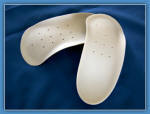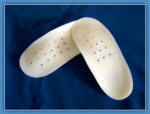|
Dress:
 Dress
orthotic is designed for patients requiring maximum biomechanical
control in normal daily Dress
orthotic is designed for patients requiring maximum biomechanical
control in normal daily walking. The
proprietary Duramaxx module offers
long lasting memory and
resiliency
combined with excellent motion control. Patient compliance is one of
the most difficult issues of orthotic
therapy.
Comfort-Step helps to overcome
compliance issues with our line of dress
orthotics which can be comfortably worn even in women's fashion
shoes. walking. The
proprietary Duramaxx module offers
long lasting memory and
resiliency
combined with excellent motion control. Patient compliance is one of
the most difficult issues of orthotic
therapy.
Comfort-Step helps to overcome
compliance issues with our line of dress
orthotics which can be comfortably worn even in women's fashion
shoes. |
|
|
All Sport:
 Comfort-Step
offers a complete line of sports orthotics designed and
custom-crafted for the active person.. Our sport orthotics are
specifically designed for injury prevention and performance
enhancement. Each sports orthotic offers unique design features
built into the Duramaxx module to accommodate the athlete's
performance needs. Comfort-Step
offers a complete line of sports orthotics designed and
custom-crafted for the active person.. Our sport orthotics are
specifically designed for injury prevention and performance
enhancement. Each sports orthotic offers unique design features
built into the Duramaxx module to accommodate the athlete's
performance needs. |
|
|
Diabetes:
Patients suffering from Diabetes
should receive a Comfort-Step gait and
pressure analysis test regularly to identify those patients at risk
for ulceration. Identifying and reducing areas of peak pressure
along the plantar surface can help prevent the development of
plantar ulcers.
 Diabetes
Type 1 (corrective) is designed for the diabetic patient
without a history of skin healing problems or plantar lesions. This
device may require extra-depth shoes. Diabetes
Type 1 (corrective) is designed for the diabetic patient
without a history of skin healing problems or plantar lesions. This
device may require extra-depth shoes. |
|
 Diabetes
Type 2 (corrective/accommodative) is designed for the
diabetic patient with a history of skin healing problems (e.g. post
lesions), or with active forefoot lesions. This device may require
extra-depth shoes. Diabetes
Type 2 (corrective/accommodative) is designed for the
diabetic patient with a history of skin healing problems (e.g. post
lesions), or with active forefoot lesions. This device may require
extra-depth shoes. |
|
 Diabetes
Type 3 (accommodative) is designed for the brittle
diabetic patient. These patients often have midfoot/rearfoot
deformities. This orthotic has soft edges to reduce irritation of
fragile skin. This device requires extra-depth shoes. Diabetes
Type 3 (accommodative) is designed for the brittle
diabetic patient. These patients often have midfoot/rearfoot
deformities. This orthotic has soft edges to reduce irritation of
fragile skin. This device requires extra-depth shoes. |
|
|
Arthritic:
There are many types of
Arthritis, all having two things in common, pain and loss of
movement. Arthritis is a degenerative joint disease in which the
cartilage that covers joint surfaces deteriorates, causing bone to
rub against bone. Comfort-Step has
developed a specific line of Arthritic orthotics to aid patients
throughout the stages of Arthritis. The Arthritic orthotic can
accommodate an existing deformity, provide increased shock
absorption, and control foot function. The use of orthotics which
combine these properties appears to reduce inflammation in the
joints of lower limbs. Their judicious use for patients with
Arthritis may help to slow the deterioration of the joints in the
feet.
 Arthritic
1: For recently diagnosed patients,
the Arthritic 1 is prescribed to accommodate an existing deformity,
to provide increased shock absorption, or to redistribute pressure
away from prominent lesions. This orthotic can control some foot
function. Combining these properties appears to reduce inflammation
in the joints of the.lower limb. Their judicious use for patients
with arthritis may help to slow down the deterioration of the
articulator facets of the joints in the feet. Arthritic
1: For recently diagnosed patients,
the Arthritic 1 is prescribed to accommodate an existing deformity,
to provide increased shock absorption, or to redistribute pressure
away from prominent lesions. This orthotic can control some foot
function. Combining these properties appears to reduce inflammation
in the joints of the.lower limb. Their judicious use for patients
with arthritis may help to slow down the deterioration of the
articulator facets of the joints in the feet. |
|
 Arthritic
2: For patients with chronic arthritis our new Arthritic
2 is designed for use in treating patients who require a less rigid,
more flexible orthotic. Orthotics of this type are usually
prescribed in order to accommodate an existing deformity, provide
increased shock absorption, or redistribute pressure away from
prominent lesions. Arthritic
2: For patients with chronic arthritis our new Arthritic
2 is designed for use in treating patients who require a less rigid,
more flexible orthotic. Orthotics of this type are usually
prescribed in order to accommodate an existing deformity, provide
increased shock absorption, or redistribute pressure away from
prominent lesions. |
|
 Arthritic
3: For the most acute cases of arthritis our new
Arthritic 3 is designed for use in treating patients wearing
extra-depth shoes who require a less rigid, very flexible orthotic.
Orthotics of this type are usually prescribed in order to
accommodate severe deformities, provide increased shock absorption,
or redistribute pressure away form prominent lesions. Arthritic
3: For the most acute cases of arthritis our new
Arthritic 3 is designed for use in treating patients wearing
extra-depth shoes who require a less rigid, very flexible orthotic.
Orthotics of this type are usually prescribed in order to
accommodate severe deformities, provide increased shock absorption,
or redistribute pressure away form prominent lesions. |
|
 Dress
orthotic is designed for patients requiring maximum biomechanical
control in normal daily
Dress
orthotic is designed for patients requiring maximum biomechanical
control in normal daily walking. The
proprietary Duramaxx module offers
long lasting memory and
resiliency
combined with excellent motion control. Patient compliance is one of
the most difficult issues of orthotic
therapy.
Comfort-Step helps to overcome
compliance issues with our line of dress
orthotics which can be comfortably worn even in women's fashion
shoes.
walking. The
proprietary Duramaxx module offers
long lasting memory and
resiliency
combined with excellent motion control. Patient compliance is one of
the most difficult issues of orthotic
therapy.
Comfort-Step helps to overcome
compliance issues with our line of dress
orthotics which can be comfortably worn even in women's fashion
shoes. Comfort-Step
offers a complete line of sports orthotics designed and
custom-crafted for the active person.. Our sport orthotics are
specifically designed for injury prevention and performance
enhancement. Each sports orthotic offers unique design features
built into the Duramaxx module to accommodate the athlete's
performance needs.
Comfort-Step
offers a complete line of sports orthotics designed and
custom-crafted for the active person.. Our sport orthotics are
specifically designed for injury prevention and performance
enhancement. Each sports orthotic offers unique design features
built into the Duramaxx module to accommodate the athlete's
performance needs. Diabetes
Type 1 (corrective) is designed for the diabetic patient
without a history of skin healing problems or plantar lesions. This
device may require extra-depth shoes.
Diabetes
Type 1 (corrective) is designed for the diabetic patient
without a history of skin healing problems or plantar lesions. This
device may require extra-depth shoes. Diabetes
Type 2 (corrective/accommodative) is designed for the
diabetic patient with a history of skin healing problems (e.g. post
lesions), or with active forefoot lesions. This device may require
extra-depth shoes.
Diabetes
Type 2 (corrective/accommodative) is designed for the
diabetic patient with a history of skin healing problems (e.g. post
lesions), or with active forefoot lesions. This device may require
extra-depth shoes. Diabetes
Type 3 (accommodative) is designed for the brittle
diabetic patient. These patients often have midfoot/rearfoot
deformities. This orthotic has soft edges to reduce irritation of
fragile skin. This device requires extra-depth shoes.
Diabetes
Type 3 (accommodative) is designed for the brittle
diabetic patient. These patients often have midfoot/rearfoot
deformities. This orthotic has soft edges to reduce irritation of
fragile skin. This device requires extra-depth shoes. Arthritic
1: For recently diagnosed patients,
the Arthritic 1 is prescribed to accommodate an existing deformity,
to provide increased shock absorption, or to redistribute pressure
away from prominent lesions. This orthotic can control some foot
function. Combining these properties appears to reduce inflammation
in the joints of the.lower limb. Their judicious use for patients
with arthritis may help to slow down the deterioration of the
articulator facets of the joints in the feet.
Arthritic
1: For recently diagnosed patients,
the Arthritic 1 is prescribed to accommodate an existing deformity,
to provide increased shock absorption, or to redistribute pressure
away from prominent lesions. This orthotic can control some foot
function. Combining these properties appears to reduce inflammation
in the joints of the.lower limb. Their judicious use for patients
with arthritis may help to slow down the deterioration of the
articulator facets of the joints in the feet. Arthritic
2: For patients with chronic arthritis our new Arthritic
2 is designed for use in treating patients who require a less rigid,
more flexible orthotic. Orthotics of this type are usually
prescribed in order to accommodate an existing deformity, provide
increased shock absorption, or redistribute pressure away from
prominent lesions.
Arthritic
2: For patients with chronic arthritis our new Arthritic
2 is designed for use in treating patients who require a less rigid,
more flexible orthotic. Orthotics of this type are usually
prescribed in order to accommodate an existing deformity, provide
increased shock absorption, or redistribute pressure away from
prominent lesions. Arthritic
3: For the most acute cases of arthritis our new
Arthritic 3 is designed for use in treating patients wearing
extra-depth shoes who require a less rigid, very flexible orthotic.
Orthotics of this type are usually prescribed in order to
accommodate severe deformities, provide increased shock absorption,
or redistribute pressure away form prominent lesions.
Arthritic
3: For the most acute cases of arthritis our new
Arthritic 3 is designed for use in treating patients wearing
extra-depth shoes who require a less rigid, very flexible orthotic.
Orthotics of this type are usually prescribed in order to
accommodate severe deformities, provide increased shock absorption,
or redistribute pressure away form prominent lesions. Our
Arch Support™
and Foot Corrector™
orthotics are made of a material called
E.V.A. (Ethyl Vinyl Acetate) which is F.D.A.
approved. Prior to casting the foot, a
proven pediograph weight bearing foot
imprint is taken to check for weight bearing
pressure. Accordingly the orthotics are made
to correct the abnormality of the foot and
restore the proper feet posture. When the
muscles and ligaments are realigned,
fatigue, and related discomfort will be
eliminated.
Our
Arch Support™
and Foot Corrector™
orthotics are made of a material called
E.V.A. (Ethyl Vinyl Acetate) which is F.D.A.
approved. Prior to casting the foot, a
proven pediograph weight bearing foot
imprint is taken to check for weight bearing
pressure. Accordingly the orthotics are made
to correct the abnormality of the foot and
restore the proper feet posture. When the
muscles and ligaments are realigned,
fatigue, and related discomfort will be
eliminated.

